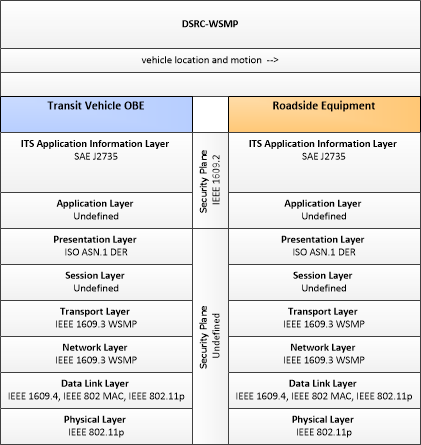Link Type: Short Range Wireless
Transit Vehicle OBE --> Roadside Equipment:
vehicle location and motion
Definitions
vehicle location and motion (Information Flow): Data describing the vehicle's location in three dimensions, heading, speed, acceleration, braking status, and size.
Transit Vehicle OBE (Source Physical Object): The Transit Vehicle On-Board equipment (OBE) resides in a transit vehicle and provides the sensory, processing, storage, and communications functions necessary to support safe and efficient movement of passengers. The types of transit vehicles containing this physical object include buses, paratransit vehicles, light rail vehicles, other vehicles designed to carry passengers, and supervisory vehicles. It collects ridership levels and supports electronic fare collection. It supports a traffic signal prioritization function that communicates with the roadside physical object to improve on-schedule performance. Automated vehicle location enhances the information available to the transit operator enabling more efficient operations. On-board sensors support transit vehicle maintenance. The physical object supports on-board security and safety monitoring. This monitoring includes transit user or vehicle operator activated alarms (silent or audible), as well as surveillance and sensor equipment. The surveillance equipment includes video (e.g. CCTV cameras), audio systems and/or event recorder systems. It also furnishes travelers with real-time travel information, continuously updated schedules, transfer options, routes, and fares. In CVRIA, a separate 'Vehicle OBE' physical object supports the general V2V and V2I safety applications and other applications that apply to all vehicles, including transit vehicles. The Transit Vehicle OBE supplements these general capabilities with capabilities that are specific to transit vehicles.
Roadside Equipment (Destination Physical Object): 'Roadside Equipment' (RSE) represents the Connected Vehicle roadside devices that are used to send messages to, and receive messages from, nearby vehicles using Dedicated Short Range Communications (DSRC) or other alternative wireless communications technologies. Communications with adjacent field equipment and back office centers that monitor and control the RSE are also supported. This device operates from a fixed position and may be permanently deployed or a portable device that is located temporarily in the vicinity of a traffic incident, road construction, or a special event. It includes a processor, data storage, and communications capabilities that support secure communications with passing vehicles, other field equipment, and centers.
Included In
This Information Flow is in the following Applications:
- Eco-Transit Signal Priority
- Intermittent Bus Lanes
- Transit Signal Priority
- Transit Vehicle at Station/Stop Warnings
This Information Flow is in the following Application Objects:
- RSE Environmental Monitoring
- RSE Intersection Management
- RSE Intersection Safety
- RSE Rail Crossing Warning
- RSE Restricted Lanes Application
- RSE Speed Warning
- RSE Traffic Gap Assist
- RSE Traffic Monitoring
- RSE Traveler Information Communications
- RSE Work Zone Safety
- Transit Vehicle Schedule Management
- Transit Vehicle Signal Priority
- Transit Vehicle V2V Safety
Communication Diagrams
The communication diagram(s) can be viewed in SVG or PNG format and the current format is SVG. Switch to PNG format.
Characteristics
Architectural:
| Characteristic | Value |
|---|---|
| Time Context | Now |
| Spatial Context | Adjacent |
| Acknowledgement | False |
| Cardinality | Broadcast |
| Initiator | Source |
Security
This information flow triple is in the following applications with the following security levels.
| Information Flow Security | |||||
|---|---|---|---|---|---|
| Application | Confidentiality | Integrity | Availability | ||
| Basis | Basis | Basis | |||
| Transit Signal Priority | Low | Moderate | Low | ||
| This data is intentionally transmitted to everyone via a broadcast. It can also be determined via other visual indicators. | This information is used in determining whether or not to grant a vehicle priority to the intersection. An incorrect message may lead to a transit vehicle not receiving a green light after requesting it, or to a light staying green for an unnecessarily long amount of time. In either situation, it should only have a small impact on traffic. | If this information is not available, the vehicle may not receive the priority it requested. In the worst case scenario the transit vehicle would be forced to wait at some lights until they turned green. It would be more useful for a device to support this application, and only have some messages received, than to not support this application at all. | |||
